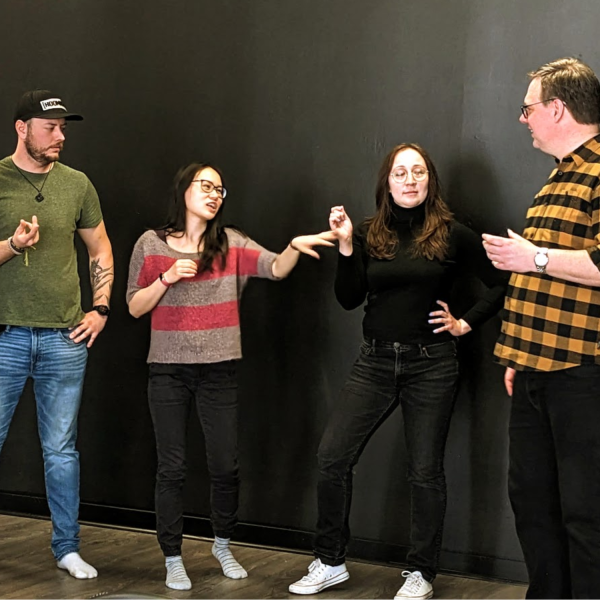You have /5 articles left.
Sign up for a free account or log in.

Students at Paul Smith’s College of Arts and Sciences participate in an improv game, learning communication skills.
Joe Conto/Paul Smith’s College
Most people recognize improvisational theater as a form of comedy, but a professor at Paul Smith’s College in New York sees potential in improv to improve student success. Hospitality and business professor Joe Conto applies the tenets of the approach to his business courses to provide a lab for professional and personal development.
In his hospitality courses, Conto uses games to help students build confidence in their communication skills as they practice improvisation with their peers. More recently, he created a course, Improv for Life Skills.
As a result of the exercises, students are more willing to work together, engage in productive discussions, practice active listening and feel confident in making mistakes.
The background: Conto is a longtime practitioner of improv, including as a student, teacher and performer. Learning improv taught him about how to better engage with others.
“I found that, not only did it give me a creative outlet, it made me a better human,” Conto says.
Improv draws on the ideas of collaboration, agreement, confidence, listening, recovering from failure and saying “yes” to divergent ideas, he explains. “It was my belief that, by incorporating classic improv exercises and games into class activities, I could help shore up some of these areas [in students].”
How it works: In business classes, Conto and his students engage in short-form improv through games. Each game is tied to a different skill or concept the student will gain.

The goal of any improv game is to build a continuous scene, building off of their partner(s) prior dialogue or established setting. This requires actors to listen before responding, creating a collaborative environment.
Joe Conto/Paul Smith's College
One example, Yes, And, is an exercise in which two students have a three- to five-minute conversation modeling one that they would have in a management situation. The goal is to teach divergence versus convergent thought; students don’t have to agree to everything, but they have to agree with the situation their scene partner establishes and move from there.
To teach active listening and working collaboratively, Conto and his students play one-word stories. In the game, students are grouped with one or more peers, and they must tell a story one word at a time, taking turns stringing the sentence together to create a story that makes sense.
Marketing demographics and knowing your audience comes to life with Mrs. Brown, a game in which students give a fictional Mrs. Brown a list of traits that all must align with one another: Mrs. Brown, for example, can’t be a fitness junkie who never works out.
This past term, the college introduced Improv for Life Skills, in which students complete a traditional improv training program to apply the skills to life beyond college in personal and professional settings. This course still includes business and management principles, but it’s entirely run like a drama course, providing a history of improvisation and how it’s used as a performance art.
The impact: Some students gain a passion for improv, and one of Conto’s classes even wants to put on an improv show at the end of this term. But interpersonal and professional skills are the main gain.
Conto has seen his students build confidence in speaking up and listening to others more effectively. Students are also nimbler in sticky situations, pivoting when things don’t go exactly to plan.
In the classroom setting, improv also increases belonging with stronger peer-to-peer connections.
DIY: For a faculty member considering adding improv to their teaching, Conto offers some advice:
- Identify learning outcomes. For a game to be effective, professors first should consider what they’re trying to teach, whether it’s communication skills, listening skills, teamwork or agreement. Then they can add elements of improv and how they apply to classroom needs.
- Make the classroom a safe space. Performance can be scary for some students, so creating a classroom environment that does not put students down and fosters peer collaboration is key. The goal is to get students comfortable with making mistakes without worrying about the consequences.
- Have a basic understanding of improv. The exercises work best when the professor is invested and involved in the process, as well as aware of the anxieties students may have in trying something new. Taking an improv class and reading resources on improv can help an instructor develop those skills.
- Be willing to be the fool. To best engage students, the professor has to be willing to commit to the exercise and bring the energy. It’s also a good management practice for students to witness, Conto says—never asking an employee to do something you wouldn’t do yourself or have done in the past.
- Create low barriers to entry. Choosing simple games can help build student buy-in. Conto also makes use of the outdoor spaces on campus to help students feel more comfortable.
Get more content like this directly to your inbox every weekday morning. Subscribe here.








